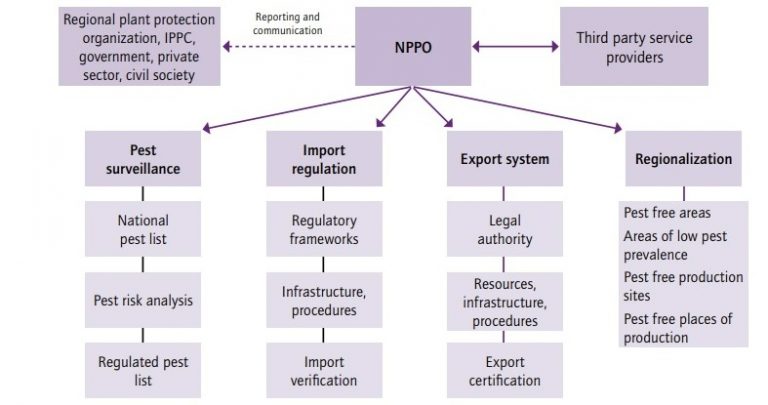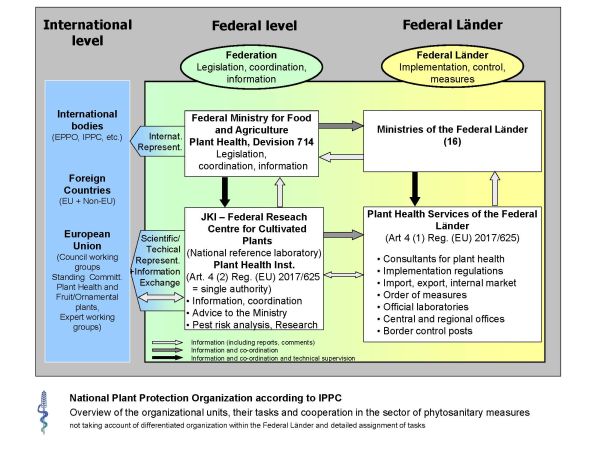In the second edition of our “Plant health policy at a glance” blog series, we explore the crucial role of National Plant Protection Organizations (NPPOs) in tackling ToBRFV and ToLCNDV in tomatoes and cucurbits through national plant health policies.
What is an NPPO?
The International Plant Protection Convention (IPPC) defines an NPPO as the “official service established by a government to discharge the functions specified by the IPPC”. The establishment of a functional NPPO is a national obligation for all contracting parties to the IPPC (i.e. a country that has joined the IPPC). The IPPC outlines both the functions of the NPPO as well as those of the contracting party. In practice however, the NPPO frequently carries out the contracting party’s responsibilities. According to the IPPC, the key functions and responsibilities of an NPPO are as follows:
- Distribute information within their territory regarding regulated pests and how to prevent and control them.
- Conduct research and investigation in the field of plant protection.
- Issuing and enforcing of phytosanitary regulations and certificates.
- Surveil growing plants in cultivated areas (e.g. greenhouses) and in wild flora, and monitor plants in storage or transportation. This should be done to report and control plant pests.
- Inspect, disinfest and disinfect plants moving in international traffic in order to prevent the introduction and/or spread of plant pests.
- Protect endangered areas and the designation, maintenance and surveillance of pest free areas and areas of low pest prevalence.
- Conduct pest risk analyses.
- Ensure that the phytosanitary security of consignments after certification regarding composition, substitution and reinfestation is maintained prior to export.
- Engage in staff training and development.
How NPPOs support plant health through their policies
In a nutshell, the IPPC determines the functions of an NPPOs, unless a country has not yet joined the IPPC. This is however rarely the case, as currently, almost all of the world’s countries (184 in total) are part of the IPPC. Essentially, NPPOs support plant health through their policies in three core areas: plant pest surveillance, import verification and export certification of plants.
In addition to their key responsibilities, the IPPC also encourages NPPOs to set their phytosanitary measures in line with the international standards for phytosanitary measures (ISPMs). This is to promote harmonization. It is also a central element of both the IPPC and the Agreement on the Application of Sanitary and Phytosanitary (SPS) Measures of the World Trade Organization (WTO). As new standards are often adopted and updated annually, NPPOs have to stay up-to-date on them. Additionally, they should also actively take part in the IPPC standard-setting process and the IPPC governance processes. Such processes include e.g. the Commission on Phytosanitary Measures (CPM).
As NPPOs have a broad set of tasks, it can be difficult for them to fully implement all their responsibilities, obligations and rights set out in the IPPC. Hence, an NPPO may need to prioritize, or even authorize other entities – public or private – to perform phytosanitary actions on its behalf. Such authorizations can include several official operations. This concerns audit, destruction, inspection, monitoring, post-entry quarantine, sampling, surveillance, testing and treatment. The International Standard for Phytosanitary Measures (ISPM) details requirements for NPPOs if they authorize other entities to perform phytosanitary actions on their behalf.
The governance mechanisms of NPPOs
An NPPO relies in the implementation of its functions on the interplay of various bodies at different governance levels. While governance mechanisms can vary from country to country, NPPOs usually follow IPPC requirements. In the EU, Member States furthermore have to comply with EU phytosanitary regulations.
Generally, a country’s NPPO governance structure includes a key role for a National Reference Center, or National Reference Laboratory. This body collaborates closely with national agriculture and food ministries by providing technical and scientific advice. It is often also chiefly responsible for diagnostics, information exchange, pest reporting and early warning. Moreover, such as Center or Laboratory is involved in coordinating phytosanitary measures on a technical level. It further elaborates the scientific basis of phytosanitary measures, in particular pest risk analysis. Finally, it liaises with other key plant health policy players. This includes the European Commission’s Directorate-General for Health and Food Safety (DG SANTE), the European Food Safety Authority (EFSA), the EPPO and the IPPC.
At regional level within countries, plant protection services support NPPOs by executing national and supranational plant health laws. They also apply phytosanitary measures. In addition to this, these services act as “first line of defense” against the entry of plant pests. They do so by conducting systematic inspections of plants at border control posts. Such checks are of course also required for the export and transit of plants. Additionally, such services are responsible for registering and authorizing companies or individuals to trade plants. This is done e.g. by issuing plant health certificates. They also collaborate strongly with the National Reference Centers or Laboratories. The services e.g. inform them immediately of any occurrence of harmful organisms, such as plant pests. For this, regional plant protection services often have diagnostic laboratories for phytosanitary examinations at their disposal.
The VIRTIGATION project and NPPOs
As a key player in shaping and implementing plant health policies, NPPOs are crucial policy stakeholders for VIRTIGATION. Several VIRTIGATION partners such as Wageningen University & Research, JKI, INRAE or Volcani Center are either directly or indirectly involved in the governance mechanisms of their countries’ NPPOs. In Germany, JKI even acts as National Reference Laboratory for the German NPPO. In the Netherlands, Wageningen University & Research collaborates closely with the Dutch National Reference Center. Subsequently, VIRTIGATION aims to continue and strengthen this close cooperation between its partners and NPPOs throughout the project’s lifetime.
Through VIRTIGATION’s research & innovation efforts in the coming years, the project seeks to support NPPOs in various ways. Firstly, VIRTIGATION aims to identify the role of seed transmission in the movement of novel viruses to Europe through the importation of vegetable seeds. Stricter seed testing prior to importation to the EU can further reduce the negative impact of emerging viral diseases. The project will communicate its findings on this issue to national quarantine agencies and seed certification agencies for their consideration and implementation.
Secondly, the project’s studies of virus diversity and ecology, as well as its enhancement of detection methods, seek to support NPPO National Reference Centers or Laboratories in improving their monitoring, prevention and control of plant pests. Thirdly, VIRTIGATION hopes to develop recommendations aimed at improving or enhancing existing standards. This includes e.g. National Plant Protection Certification, to further support NPPOs in their work. Finally, the project will also provide its envisaged protocol for decontamination of growing substrate and disposal of ToBRFV-infected plant material to NPPOs. This should contribute to enhancing current ToBRFV decontamination protocols.


